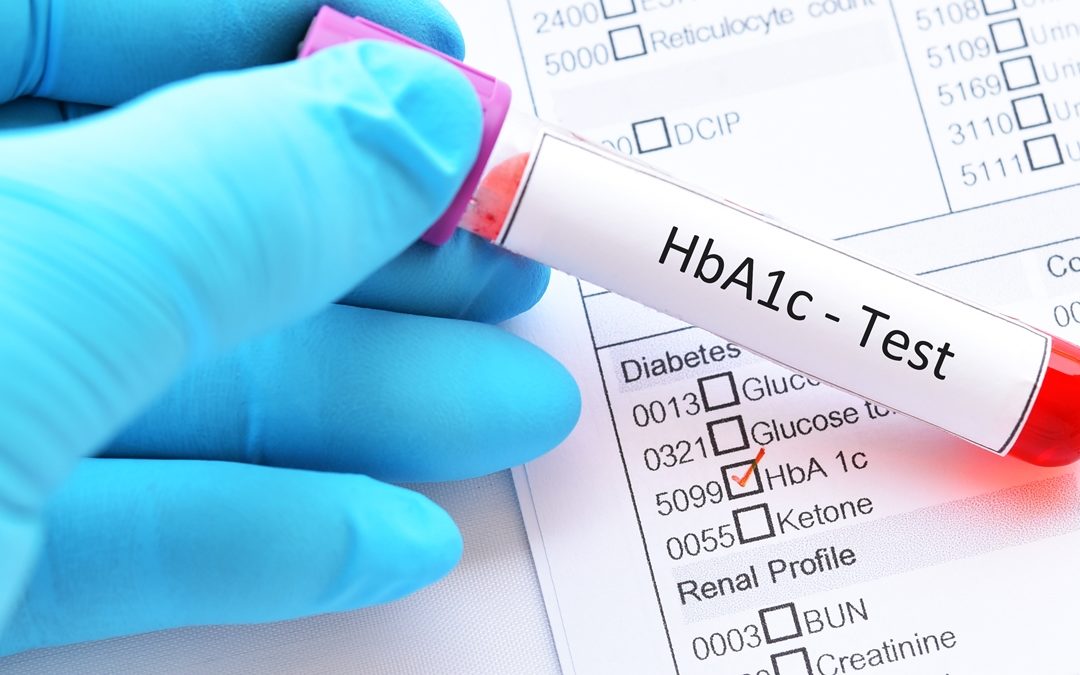In this article, you will learn about hemoglobin A1c (HbA1c or A1C) testing and its important role in the long-term monitoring and management of diabetes. You will learn how HbA1c testing works, what the results mean and how to lower your HbA1c levels. Also, you will learn about the OneDraw A1C Test System (“OneDraw”), which consists of a new method of blood sampling for HbA1c testing. The OneDraw A1C Test System includes the OneDraw Blood Collection Device, a convenient and more comfortable way to draw blood compared to traditional blood draws.
Diabetes and HbA1c
Broadly speaking, the term “diabetes” describes a group of metabolic disorders characterized by chronic high blood sugar.(1) There are two types of diabetes. Type 1 diabetes occurs when a patient’s pancreas produces little to no insulin, a hormone that helps the body metabolize glucose. Type 2 diabetes is characterized by the onset of insulin resistance, wherein the body fails to respond to insulin properly over time.(2)
Among other uses, the HbA1c test (“A1C test”) helps patients with diabetes and prediabetes track average blood glucose (or “blood sugar”) levels over time.(3) With regular testing, patients can monitor their progress and track the impact medication, lifestyle, and healthy habits have on their blood sugar.
What is the HbA1c protein?
Hemoglobin, found within red blood cells, transports oxygen to cells throughout the body. Glucose naturally attaches (or “binds”) to hemoglobin, a process called glycosylation, leading to an identifiable protein called HbA1c.(3)
The higher a patient’s average blood sugar levels, the more glycosylation will occur – leading to more detectable HbA1c.(3)
Why did my doctor prescribe an A1C test?
Your doctor likely prescribed you an A1C test because you have diabetes and require regular monitoring of blood glucose levels; because he or she believes you are showing signs and symptoms associated with diabetes or prediabetes; or, because blood sugar testing – based on family history, lifestyle, or other information you’ve provided your doctor – is part of your annual medical assessment (or “check up”).
The A1C test is typically performed at a doctor’s office via a blood draw using a fingerstick or a point of care A1C test. Your physician or a phlebotomist would draw blood and send it off to a certified laboratory, which has the equipment and trained personnel needed to accurately identify HbA1c levels in the bloodstream. Based on the test results, your physician will determine progress towards managing your total blood glucose levels.
What does the A1C test measure?
The A1C test is generally used alone or in conjunction with other tests to identify high blood glucose levels. The test measures the relative amount of glycosylated hemoglobin (HbA1c) compared to the total hemoglobin in your blood.(4) The test is expressed as a percentage, with a higher percentage indicating higher average blood glucose levels over the last 60 to 90 days.
One reason why A1C tests are so valuable: blood glucose levels fluctuate regularly based on physical activity, illness, stress, and other acute circumstances. Accordingly, HbA1c readings – which measure an average over the course of 60-90 days – are less likely to be impacted by daily factors.(5)
How is the A1C test used to monitor diabetes?
It is recommended that patients diagnosed with diabetes monitor their HbA1c levels over time to assess the progression of the disease, the effect of any medications prescribed by their physician, and the impact of lifestyle changes.
“In 2019, the American Diabetes Association (ADA) recommended a reasonable A1C goal for many non-pregnant adults is < 7 % (53 mmol/mol). Providers might reasonably suggest more stringent A1C goals (such as 6.5 % [48 mmol/mol]) for selected individual patients if this can be achieved without significant hypoglycemia or other adverse effects of treatment. Less stringent A1C goals (such as <8% [64 mmol/mol]) may be appropriate for patients with a history of severe hypoglycemia, limited life expectancy, advanced microvascular or macrovascular complications, extensive comorbid conditions, or long-standing diabetes in whom the goal is difficult to achieve despite diabetes self-management education, appropriate glucose monitoring, and effective doses of multiple glucose-lowering agents including insulin.” (6)
American Diabetes Association. “Standards of Medical Care in Diabetes” – 2019 (Volume 42, Supplement 1″)
New solution for long-term monitoring of HbA1c
While HbA1c testing has been an established part of diabetes management for decades, traditional blood draws present substantial challenges that newer technologies – such as OneDraw from Drawbridge Health – are addressing.

With OneDraw, patients receive reliable A1C test results through a convenient, almost painless process that streamlines sample acquisition and lab shipping.
How accurate is the test?
Like any test, taking multiple draws in a short period of time may present a small variance in results.
If your doctor suspects that your HbA1c results don’t align to expectations – based on previous readings or your reported signs, symptoms, and lifestyle – he or she can have a confirmatory test performed, or alternatively, supplement the test with an additional, non-A1C test designed to assess blood sugar levels.
How are my test results used?
Your physician will use your series of A1C test results to monitor your blood sugar levels over the course of months and years, identifying treatment and management strategies, and adjusting your care regimen accordingly.
What are the implications of high HbA1c?
High HbA1c levels are associated with symptomatic diabetes and prediabetes. (2)
If your HbA1c levels are consistently high, you may be at risk for developing symptomatic diabetes, which adversely affects your overall health in diverse and intricate ways, or it may be an indication that the therapeutic treatment you are following is not sufficient.
What HbA1c goal should I have?
There are specific guidelines set by medical associations, such as the American Diabetes Association. Your physician will factor these recommendations along with your medical history, family history, and general health to determine a target A1C level that is right for you.
Why do I need an A1C test at regular intervals?
Regularly monitoring your A1C levels is important. For non-diabetic or undiagnosed individuals, checking A1C levels annually or semi-regularly is important for confirming overall health and ensuring blood sugar levels remain normal. For patients living with diabetes or prediabetes, regular monitoring – at least twice a year – is recommended to measure the effect of medication and/or lifestyle changes aimed at lowering blood glucose, mitigating symptoms and promoting health and wellness.
How do I lower my HbA1c levels?
If you have been diagnosed with diabetes or prediabetes, your doctor will help you develop a comprehensive plan aimed at lowering your overall blood glucose and A1C. This plan could include pharmacological options, such as specific medications. It could also include health and wellness strategies such as an exercise regimen, a nutritious diet comprised of whole foods and little sugar, and ways to manage stress and fatigue.
Conclusions
Regular HbA1c testing is a critical component of successfully monitoring and managing diabetes, an increasingly prevalent and impactful disease. With OneDraw from Drawbridge Health, taking blood samples for regular A1C tests is more comfortable and convenient than ever before – meaning there’s never been a better time to make regular testing and conscientious care a priority.
References
- “Diabetes.” https://medlineplus.gov/diabetes.html
- “Types of Diabetes Mellitus.” https://www.webmd.com/diabetes/guide/types-of-diabetes-mellitus#1
- “Hemoglobin A1c Test (HbA1c).” https://www.emedicinehealth.com/hemoglobin_a1c_hba1c/article_em.htm#how_is_hemoglobin_a1c_measured.
- “HbA1c”, https://kidshealth.org/en/parents/hba1c.html
- “All About the Hemoglobin HbA1c Test.” https://www.healthline.com/health/type-2-diabetes/ac1-test#understanding-the-results
- “American Diabetes Association. “Standards of Medical Care in Diabetes” – 2019 (Volume 42, Supp.1″. https://care.diabetesjournals.org/content/42/Supplement_1

